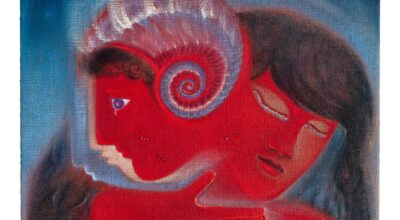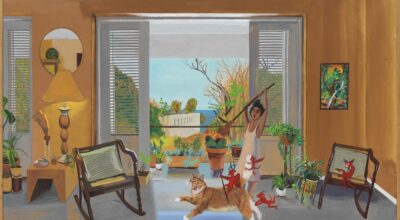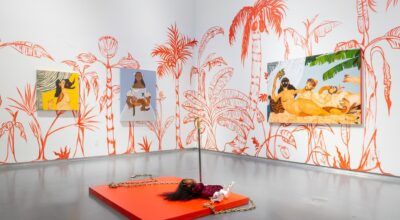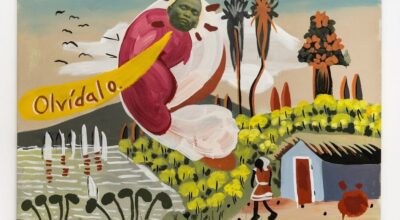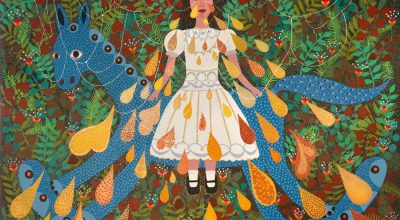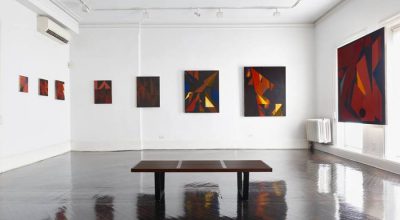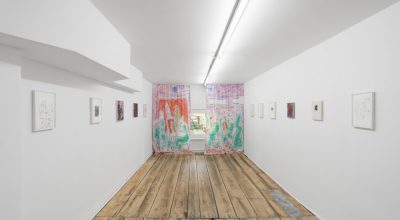painting
DANIEL CORREA MEJÍA: SOY EL DUEÑO DE MI CASA
Confronting himself with the complexity of being responsible for his own house, his own existence as a breathing and individual body, Mejía (b. 1986 Medellín, Colombia, based in Berlin) finds through his work an expanded notion of home -one that is not limited to four walls or even the confines of the physical body.
MARÍA BERRÍO: WAITING FOR THE NIGHT TO BLOOM
Based in Brooklyn, María Berrío (1982) grew up in Colombia. Her large-scale works, which are meticulously crafted from layers of Japanese paper, reflect on cross-cultural connections and global migration seen through the prism of her own history. «Waiting for the Night to Bloom» is the first survey of her work, on view until May 9 at the Norton Museum of Art (West Palm Beach, Florida).
HULDA GUZMÁN: MY FLORA, MY FAUNA
The works in «Hulda Guzmán: my flora, my fauna» reveal an artist in exuberant introspection and exploration of reality and perspective through her distinct iconography —informed by her imagination and the flora and fauna in her surroundings within the Dominican Republic. Guzmán renders a world in which children, adults, animals, plants, and invented creatures alike come together to dance, lounge, congregate, share secrets, and play —all colored and enriched by embracing nature and celebrated through the act of painting.
BONY RAMIREZ: MUSA X PARADISIACA
Behind Ramirez’s muses lie saturated, playful colors, or landscapes of quintessential Caribbean beaches, jungles, and paradisiacal symbols. Accompanying many of his subjects are still lifes with tropical fruits, shells, and plants like the “flamboyant tree” and plantains (scientifically, Musa x Paradisiaca). He uses the traditional elements of Renaissance portraiture, but adapts them with Caribbean iconography, rendering his works’ subject matter away from white gentry to those affected by European colonialism.
JOSÉ LUIS VARGAS: MYTH-MAKING
The faces and figures in the work of José Luis Vargas (Puerto Rico, 1965) become surrogates of very deep thoughts related to a sharper gaze. The duality in the works were created by many years working with people from different backgrounds, and his studio practice interestingly submerged the people that inhabit the paintings. People on the edge of the sublime and the mythical without forgetting their human nature.
AGNES PELTON: DESERT TRANSCENDENTALIST
«Desert Transcendentalist» is the first solo exhibition devoted to Agnes Pelton (1881–1961), a pioneer of American abstraction, in twenty-five years. This is a rare opportunity to experience Pelton’s profoundly spiritual body of work and to confirm her place in art history. Pelton received little critical encouragement for her abstract paintings during her lifetime as a result of living away from the mainstream art world for most of her career.
Gerardo Rosales:looking For a Hero or Whips, Whims, And Wigs And Gio Ponti is Just an Excuse
In his recent works, Rosales exposes issues of social inequality experienced by immigrants coming from Latin America in search of a better life in The United States. An immigrant himself, Rosales moved to Houston from his native Venezuela 19 years ago. Rosales’s art appropriates aesthetic genres associated to folk art and geometric abstraction to call attention on issues of class, race and gender, at times with biting humor, while other times with loaded, painful drama.
Louis Fratino:come Softly to me
Drawing inspiration from personal experience and, more recently, photographic source material, Louis Fratino makes paintings and drawings of the male body. His work includes portraits, nudes, and intimate scenes of male couples engaged in activities ranging from the mundane to the graphically sexual. The result is a body of work that is a loving and honest expression of the contemporary gay experience.
Jaime Gili:dark Paintings
Jaime Gili’s painting is steeped in the paradox of an abstract practice whose meaning depends largely on referentiality. Despite the artist’s long-term commitment to the mostly flat and broken planes of geometry in an investigation of color that delights in the specificities of materials and technique, Gili’s paintings are mostly discussed in relation to the histories of prewar and postwar geometric abstraction that circulate globally.
Cosima zu Knyphausen.a Studio of One’s Own
Self-portraits and records from the studios of those invisible female artists who never entered the canon of art history are subject of Cosima zu Knyphausen’s artistic investigations. Her ensuing series of work, often reduced to the essentials and multiply duplicated (and sampled), are reminiscent of exercises -sometimes very sketch-like, sometimes less so, sometimes with thoroughly painted areas or with unexpectedly interrupted lines.

